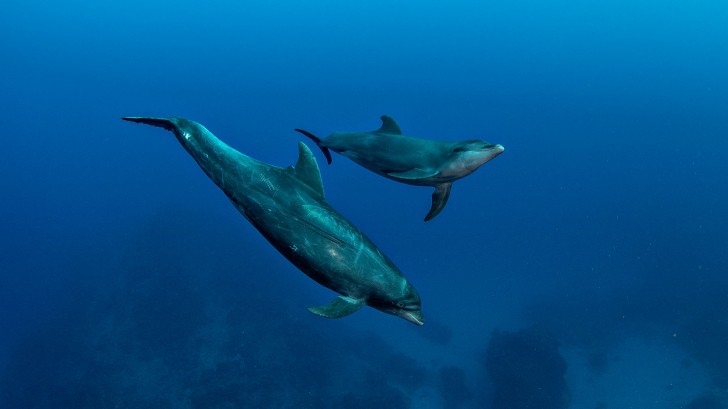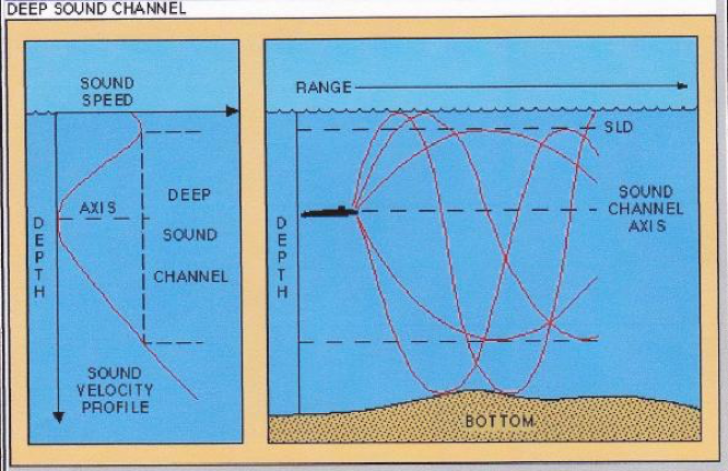It might be invisible to us standing on the ocean’s shore, but beneath the waves, the ocean churns with a constant orchestra of noise.
Under the waves, light vanishes. By just 200m below the surface, photosynthesis becomes impossible. At 1,000m down, sunlight disappears entirely. The deep ocean – the largest habitat on earth – is also the darkest.
As light becomes increasingly irrelevant underwater, sound becomes more important than ever.
It’s unsurprising that cetaceans – dolphins and whales – rely on sound more than any other sense to understand, navigate and manipulate their world.
While apes are renowned for their colour vision, and humans like to think of themselves as visual creatures, cetaceans have no use for expensive ocular equipment. Instead, they have evolved some of the most distinct, complex and unique acoustic anatomy and behaviour on earth. Cetaceans see and feel with sound.
“Studying the acoustic capacities of cetaceans is about discovering evolution’s creativity,” says Professor Christopher Clark, a cetacean specialist in the Department of Neurobiology and Behavior at Cornell University.
“All humans have been doing for the past 70 years developing sonar detection equipment, really, is learning from cetaceans about how they do what they do, and trying to figure out how to use our own sonar systems in a similar way to what they have been doing for millions of years,” he says.
Sound travels faster and further in water
Sound waves travel far faster and far further through water than they do through air: roughly 1500m per second in seawater, compared to just 340m per second in air – more than four times faster. Sound is created by waves of vibration that pass through a medium, such as water or air. Because the atoms in liquids are more tightly packed than in gases, sound travels much faster in the ocean.
Evolving for an underwater world
When the ancestors of all dolphins and whales moved from the land into the sea, almost all aspects of their anatomy changed drastically to adapt to their new world: their eyes shrank, their front limbs morphed into flippers, while their hind legs merged into fins. Body hair vanished, no longer helpful for retaining heat, and in its place body fat swelled into thick outer shells of blubber to allow whales to maintain their body temperature even in the coldest waters of the world.

The animals that echolocate – including us
Prof Rossiter also studies insect-eating bats which, like toothed whales, can echolocate: like dolphins, they emit high-pitched chirps in a rapid fire burst, and by listening to the echoes can locate prey and navigate through their habitat.
“You can see how echolocation would evolve if you’re in a dark environment like a cave or the deep ocean – there are in fact many blind humans who have learned how to echolocate, and even normal sighted people can tell if they are in a huge chamber or a crowded room just by listening to the acoustics,” he says. “But while bats have a typical mammalian ear, cetaceans have a much more specialised system.”
Evolving for sound
The evolutionary changes to the auditory equipment in dolphins and whales needed to be dramatic to accommodate the acoustic environment of the sea. Because water is denser than air sound waves enter the cetacean ear without a change in something called “acoustic impedance”: sound waves travel in a straight line through the head, rather than at an angle as in land-dwelling animals. The lack of a change in the speed or power of a sound wave as it reaches the skull of a whale generates what is called “acoustic interference” between the two ears, which affects their ability to locate the source of a sound.
To counteract this, cetaceans have evolved to have a pocket of air inside each ear. The middle ear structures have moved from inside the skull to outside of it: the tympanic membrane (ear drum) and the ossicles (ear bones) are housed within a giant bulbous bony shell called the “tympanic bulla”.

There are other anatomical quirks that make the cetacean auditory equipment so unique: the tympanic membrane is shaped like a cone and projects into the bulla, rather than stretched flat like a drum across the opening to the ear canal as in our own species. “In a baleen whale, the membrane is like a big flag flapping around on a flag pole, while in dolphins it’s more rigid, like a tuning fork,” says Prof Clark.
And toothed whales, or “odontocetes”, are able to receive sounds through their lower jaw, which transmit the sound waves into the ear.
Pitch perfect
Put everything together, and cetaceans are equipped with an evolutionarily distinct apparatus that allows them to perceive and utilize sounds unlike any other group of animals on earth. While humans can hear sounds ranging from 20Hertz (Hz) to 20,000Hz, bottlenose dolphins can hear up to 160,000Hz – beyond the range of dogs, famously sensitive to high pitches we cannot hear: they tap out at 44,000Hz. All creatures on earth use sound waves to some degree, but toothed whales are the sonic masters of the upper registers of the animal kingdom.
It’s all about that bass
Baleen whales on the other hand rule supreme over the lower registers – the bass notes of the zoological musical scale. While toothed whales emit high-pitched whistles to communicate with each other, and even higher pitched clicks to pinpoint prey, baleen whales sing to each other with rumbling, low moans and growls that often are too low for humans to hear – blue whales for example can make calls just 14Hz in frequency, invisible to our ears.
Because low frequency sounds travel further with less scattering, distortion and transmission loss, baleen whales can communicate to each other over enormous distances – thousands of kilometres.
They accomplish this through an ingenious tactic: making their calls within something called the “deep sound channel”, also known as the SOFAR channel (for Sound Fixing and Ranging channel). Due to the physical properties of the ocean, sound waves diminish in volume rapidly close to the surface, but at varying depths below the surface, depending on latitude, sound waves suffer little transmission loss and increase in the speed at which they travel.
The song that travels for miles
Whale songs can travel for thousands of kilometres through this horizontal band of water, which is often termed an “acoustic guide”. Cold war scientists discovered the channel in the 1940s and figured out how to utilise it in submarine warfare, but strategically using the channel to listen for Soviet subs thousands of kilometres away.
Whales are experts at long distance communication
Long before the navy figured out how to harness the acoustic properties of the ocean’s depths to send signals as far as possible, whales developed behavioural strategies to communicate with each other over enormous distances: the call of a fin whale for example may travel 250km at the surface, but more than 6,000km in the deep sound channel.
“If a whale is near the surface, their calls will bounce off the surface of the sea and the ocean shelf, and quickly dissipate,” explains Prof Clark. “But once that animal plummets into the abyss, due to the physical refraction of the ocean, the energy of their calls get trapped in this layer and can travel farther and faster. That’s how I can hear blue whales singing off the coast of Ireland with a hydrophone placed in the water in Virginia.”
Baleen whales use this channel not just for communicating with each other, but also for navigating, by listening to the echoes of their calls bouncing off distant ocean shelves and coastlines, creating mental maps of the ocean.
“I have tracked blue whales slaloming from sea mounts to islands to shelves – they don’t move in random directions, to go straight for features that are illuminated by their voices, sending out calls with wavelengths as long as a football pitch. It’s not echolocation, it’s more like ‘echomapping’ or ‘echoraging’,” he explains.
“To study these animals I had to completely change my sense of time and space, because sound waves travel 25km in just one minute – so if a sound has to travel 250 miles to hit a coastal shelf, it will take ten minutes to hit the shelf and then ten minutes to come back. Humans just aren’t used to waiting twenty minutes to hear an echo. But these animals can do this, creating acoustic maps of their environments.”
The loudest animal of all
Not only can baleen whales emit calls that travel farther than any other voice in the animal kingdom, these giants of the deep also create the loudest vocalisations of any creature on earth: the call of a blue whale can reach 180 decibels – as loud as a jet plane, a world record.
The longest song of all
Baleen whales also create the longest-lasting calls in the animal kingdom, with their famous songs (believed to be for reproduction, though that remains unproven). The world record holder for this is the humpback whale: males will sing for several hours at a time (repeating one song about 10 minutes in length over and over). The patterns of shrieks, growls and moans they sing repeats – just as human musical melodies do – and while a single session usually lasts up to 30 minutes, they have been known to last up to 23 hours.
Humpback whales are also the world record holders for the number of vinyl records pressed of their music: 10 million copies of Songs of the Humpback Whale were inserted into National Geographic magazine in 1979 – in 10 languages. Humpback whales have what many zoologists to be a form of culture: whales in different regions will have different songs from year to year, all the males singing the same song, what musicologist David Rothenberg, author of Thousand Mile Song, describes an “anthem”. Remarkably, humpbacks can collective change the song as a group – within a week all the males will synchronise with each other to a new pattern of shrieks, growls, moans and rumbles.
The discovery of whale song
Though ancient sailors were known to hear the calls of whales through the hulls of ships, they likely didn’t know what they were hearing (and it is thought attributed the sounds to mermaids). Scientists only discovered whale song in the 1950s when American scientists stationed in Bermuda heard the calls while listening out for Russian submarines.
For 15 years, the navy kept the knowledge of whale songs a secret, until in 1967 engineer Frank Watlington gave recordings of the songs to biologist Roger Payne, who was a specialist in bat and owl vocalisations. Watlington had discovered that the whale songs consisted of a series of phrases that would be repeated perfectly, over and over.
Payne went on to study humpback whale songs, and discovered that all the males in a population will sing a new song every year. Together Payne and Watlington released the songs as the album Songs of the Humpback Whale in 1970, and arguably kick-started the environmental movement. When millions of people became aware that these incredible songs came from animals that humans had been slaughtering en mass for hundreds of years, huge protests led to the 1972 United Nations Conference on the Human Environment 10-year global moratorium on commercial whaling – which at the time was close to driving whales completely into extinction.
Inadvertently, military research led to biological enlightenment and conservation movements.
Dolphins in the military
The American military had other reasons to take a closer look at the acoustic talents of whales and dolphins. Toothed whales such as dolphins, killer whales and belugas, use echolocation not just to map their environment, but to find their prey. By vibrating the “phonic lips” on their nasal bulbs at the top of their heads, dolphins and porpoises channel beams of sound through the melon (the globe of oily tissue in their forehead) towards their prey, and by picking up the echoes that bounce back (mostly through the jaw), can figure out not just the location of a fish, but also how big it is.
Dolphin echolocation is so sensitive, they can figure out the size of a fish based on the size of the swim bladder (a sac full of air that fish use to move vertically in the water). Beluga echolocation is even more sensitive. They can discern the shape of an object behind an opaque screen. No human technology can do this.
So it is no surprise the military realised they could learn a thing or two from dolphins about how to use sound underwater. Military scientists in four countries – the US, Russia, Iran and the Ukraine – have all worked with dolphins: one, to study how they echolocate in the hopes of designing better submarines and sonar detectors. And, two, to train them to listen for approaching submarines, reveal the location of buried explosive devices underwater, and uncover the identity of suspicious objects.

American scientists began working with dolphins in the 1960s, training them during the Vietnam war not only to hunt for mines, but also to stick explosives onto enemy ships and even to stick needles full of carbon dioxide into enemy divers. The American military still has a dolphin unit, currently spending about $20m a year on more than 100 animals at the Point Loma submarine base near San Diego.
“They are still part of naval research because you just can’t replace them – the navy has wanted to replace the dolphins for as long as I know of, but they can’t because we don’t have any sonar system that can beat theirs. We cannot for example reliably detect mines that have been buried in the sand, but dolphins not only find them, they also don’t give us false alarms, such as spotting something that just turns out to be a rock,” explains Professor Whitlow Au, Researcher Emeritus in the Marine Mammal Research Program at the Hawai’i Institute of Marine Biology.
Dr Au began studying dolphin echolocation in the 1970s when he was recruited by the navy as an electrical engineer to study biosonar in order to develop new instruments for the military. One of his first studies examined how far away a dolphin could detect a small spherical object in open water.
He discovered that animals in the wild emit echolocation chirps that are up to 100 times louder than animals in captivity (the only animals that had been studied in detail). The animals vary the volume of their vocal calls, he says, to suit their environment – hence why animals in tanks are much quieter. This finding was so “astonishing” he says that his first research paper was rejected because the animal’s capacities seemed improbable.
“I had to go through rigorous testing on all my equipment before they finally accepted the paper for publication,” he says.
After that, his work with the military went “downhill” he says. “I wanted everything I worked on to be published in the open literature – I didn’t want things to remain classified. I was more concerned about my contribution to science,” he says.
Unanswered questions
As it happens, Professor Au became far more fascinated by dolphin biology than military technology, and he went on to spend four decades studying cetacean echolocation, earning him the nickname of “godfather” of the entire field cetacean acoustics.
“There are still so many unanswered questions,” says Prof Au. “How can they discriminate objects from such long distances? And why do they have this ability? What kinds of signals do they receive? How do they process them?”
Professor Wenwu Cao in the Department of Mathematics at Penn State Materials Research Institute published a study last year in the journal Physical Review Applied describing how porpoises can use the oily material in their heads (described as a “meta material”) to create narrow beams of sound instead of regular sound waves that travel in all directions.
“We began our study by trying to figure out why such a small animal with such a small head could locate fish very far away – this ability could not be explained by textbooks,” he says. “They use muscles to physically deform their heads to change the angle of the beam – this was not known at the time. But we still don’t’ understand how exactly they receive the signals. I also want to understand how they form clear images.
“For us, we have two eyes, which we use to form three dimensional images. But with their acoustic system, we still don’t know how they receive information from objects at different angles. It could be that they use their ears, or it could be that they use their teeth – we still don’t know.”
Prof Cao will continue to study the echolocation of toothed whales because this and other questions remain. As Prof Au, who studied dolphin echolocation for four decades puts it: “These are fascinating animals with very fascinating abilities – these are the things that keep zoologists going,” he says.
